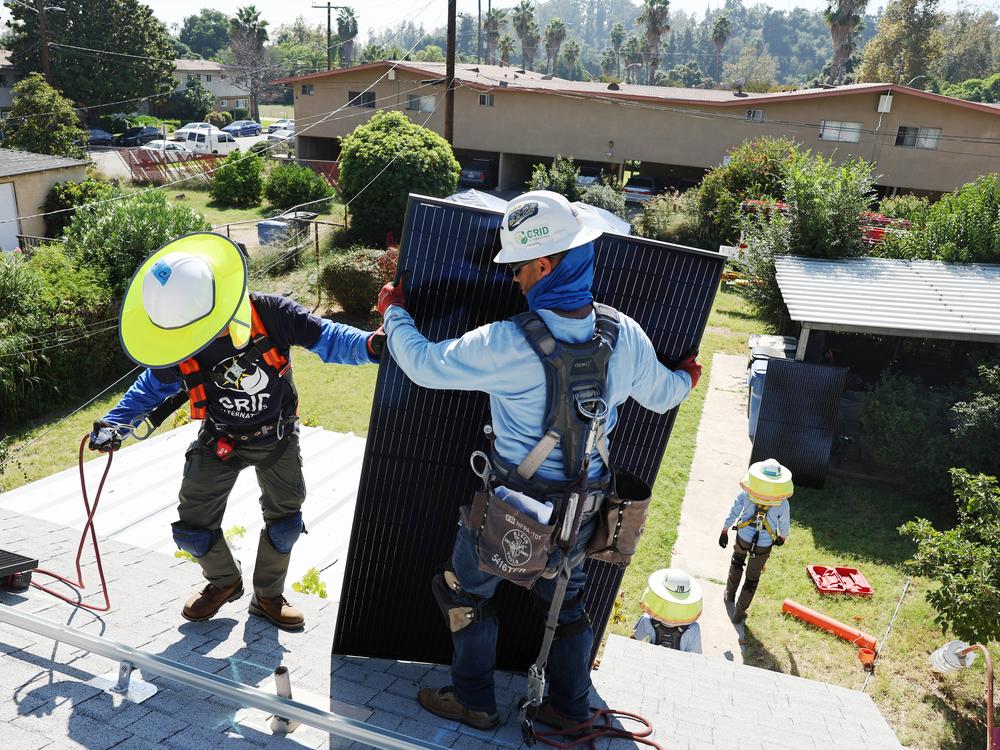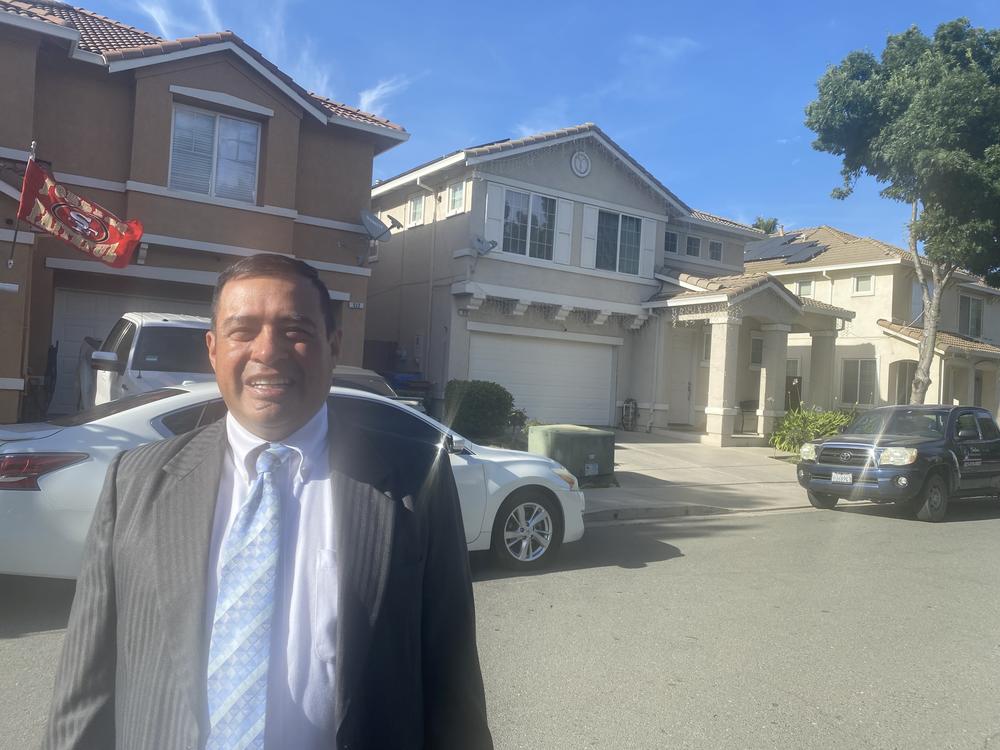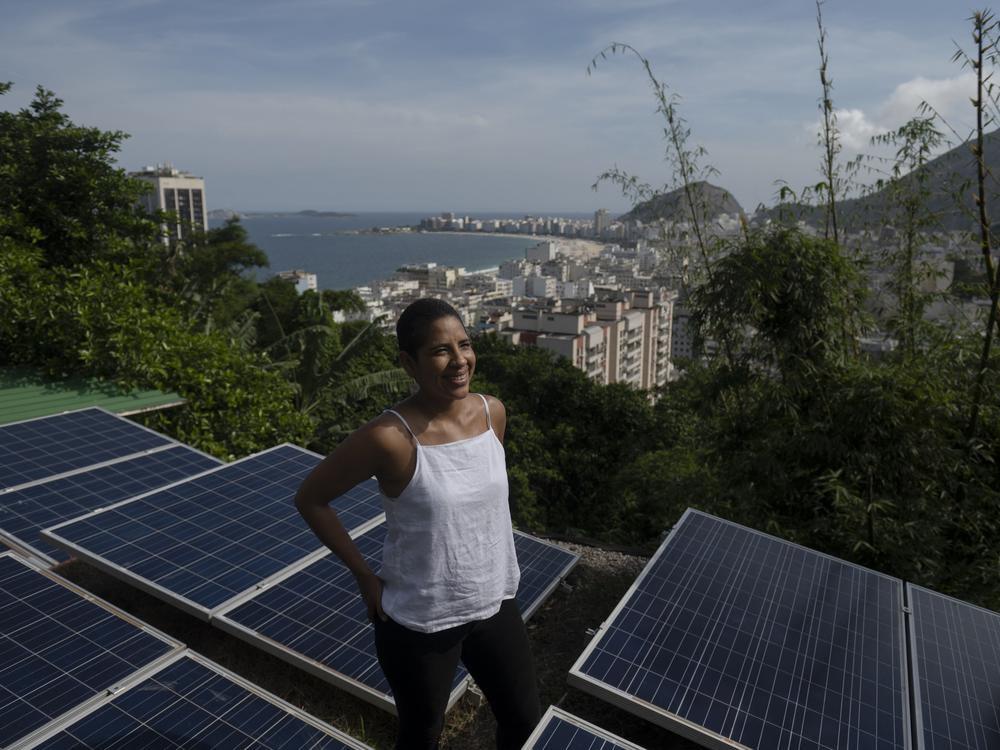Section Branding
Header Content
Why the U.S. government is spending $7 billion on solar for low-income homes
Primary Content
Pittsburg, Calif.-- On a hot afternoon in a suburb of San Francisco, Hugo Salas stands in the middle of the street looking up at the reason why his electric bills are so low.
Salas has solar panels on his rooftop, which he got through a nonprofit program designed for low-income households. Salas, an ironworker, didn’t pay anything for the panels - except for the Peruvian food his wife made for the workers who installed the panels.
“It helps us a lot, those of us with solar,” Salas says in Spanish, “because you actually save a little money.”
The nonprofit that gave Salas the panels is called GRID Alternatives, and it, along with other awardees, is about to get a big boost from the federal government. Later this summer the Environmental Protection Agency expects to begin distributing $7 billion through its “Solar for All'' grants. By funding programs that provide rooftop solar panels, batteries to store solar energy, and community solar farms, the EPA expects to help more than 900,000 low-income households reduce pollution that drives climate change, and reduce bills.
Across the world, from China to Brazil, solar energy is being used not just to cut planet-heating gasses from fossil fuels, but also to alleviate poverty. This is increasingly also the case in the U.S.
Electricity bills have risen in recent years – including because utilities are passing along costs of growing climate-fueled disasters like wildfires onto customers. And more frequent and intense heat waves mean more people need air conditioning, which also adds to bills.
Solar programs can shield low-income customers from high electricity bills. But the new federal program faces challenges, including distrust from some low-income communities who think solar is a scam. And while the EPA aims to get this money out the door in the next few weeks, former President Donald Trump has attacked what he calls the “green new scam” and has campaigned on ending President Joe Biden’s energy and climate policies. A future Trump administration could cut back the implementation of some current clean energy programs, says Costa Samaras, director of the Scott Institute for Energy Innovation at Carnegie Mellon University and a former senior energy advisor in the White House.
Samaras says he thinks Solar for All will be harder to cut. “Taking away the opportunity for people to save money on their electricity bills, I don't think it's going to be popular,” he says. “Saving money on electricity is popular.”
The Trump campaign did not respond to a request for comment.
Rooftop solar, community solar, and batteries
The way rooftop solar works, the solar energy you create can power your own home’s electricity needs, and then any extra power you make goes back to the grid for a credit with your utility. Those credits can reduce a household’s energy bills, says Ben Inskeep, program director of Citizens Action Coalition, an Indiana nonprofit focused on energy and environmental policy.
“The bottom line is a lot of homeowners that have gone solar are now seeing very low utility bills,” Inskeep says.
Rooftop solar adopters still tend to be wealthier than their neighbors. Rooftop solar panels and installation have a median cost of around $30,000 before government incentives, according to Lawrence Berkeley National Laboratory (LBNL). But prices for panels and installation are falling, and with more leasing and loan financing programs, there’s “a slow but steady movement” towards more low-income homes with rooftop solar, says Galen Barbose, staff scientist at LBNL.
The “Solar for All” grants aim to speed up that shift, says David Widawsky, director of the EPA’s Office of the Greenhouse Gas Reduction Fund, which manages the program.
But it isn’t just rooftop solar. Widawsky says the money will also go towards batteries that allow solar customers to store their energy. And it will go towards community solar, which allows customers to tap into solar generated at a shared site, like a solar farm.
Community solar is a key way for people who have too much shade or can’t install rooftop solar for other reasons to participate in solar. It’s also helpful for the more than a third of Americans who are renters. Customers typically receive monthly credits for the share of solar they help “produce,” which reduces their utility bills.
Research suggests the Solar for All program could have an impact far beyond the projected 900,000 plus households, says Sanya Carley, professor of energy policy at the University of Pennsylvania. A lot of what inspires solar adoption - regardless of income level - is seeing your neighbors and friends have it.
Solar as a poverty alleviation tool
Most of the “Solar for All” money will go through state entities like the Michigan Department of Environment, the West Virginia Office of Energy, and the Kentucky Energy and Environment Cabinet. Those entities then give grants to lending institutions that fund solar and battery projects, and to installers and project developers themselves. Some funding will also go to organizations focused on expanding solar for tribal communities. And some money will go through multi-state programs like GRID Alternatives, the solar non-profit that helped Salas get solar in California.
Since getting rooftop solar, Salas hasn't paid more than $165 a year to his utility, PG&E. California households pay about $147 per month on average to their utilities, according to the nonprofit National Energy Assistance Directors Association.
Having solar also allows Salas to run his air conditioning in his increasingly hot neighborhood. “You don't worry about saying ‘Oh, I'm going to use a lot of electricity if I use the air conditioning,’” Salas says.
Carley says this is a common scenario. Having solar that reduces energy bills means families put more money towards food, medicine and keeping air conditioning at a setting that’s “liveable,” she says.
Also rooftop and community solar can help households avoid power shutoffs, which are dangerous in extreme heat and cold. “We know that households that have access to solar that can reduce their energy bills are able to avoid disconnections more often than those that don't,” Carley says.
The EPA estimates the program will produce over $350 million in annual savings on electric bills for low-income households.
Wage requirements and solar scams
Some solar installers working on “Solar for All”-funded projects will be subject togovernment requirements to pay “prevailing wages”— which may mean having to pay laborers more than they currently do. That may add significant costs for those project installers, and it’s still unclear how big they might be, Carley says.
An EPA spokesperson writes in an email that Solar for All is providing “explanation and guidance” on the requirements to grant recipients, including helping them access web-based tools to calculate what they need to pay laborers where they operate.
But Widawsky says there are other hurdles for this program, including predatory lenders that have made some communities wary. “The fact is that there are some unscrupulous characters operating in the solar space,” he says.
The EPA funding will help local governments and communities create lists of reputable solar actors who can use the EPA funding and help build trust in solar, Widawsky says.
As for Salas, he recently spoke with a neighbor about getting solar panels. She told him she didn’t want to waste her time because solar panels were a “scam”.
“I told her, ‘No. It isn’t a scam. I have it, and it helped me,’” Salas says.



